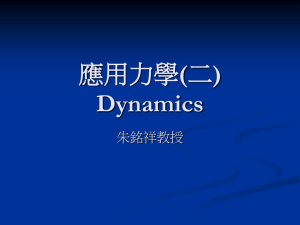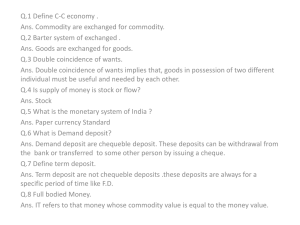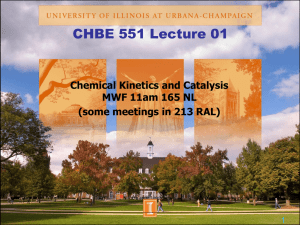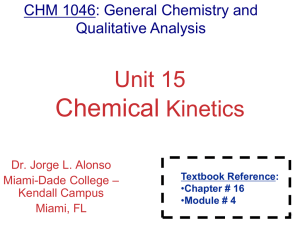Solid-liquid reaction kinetics
advertisement
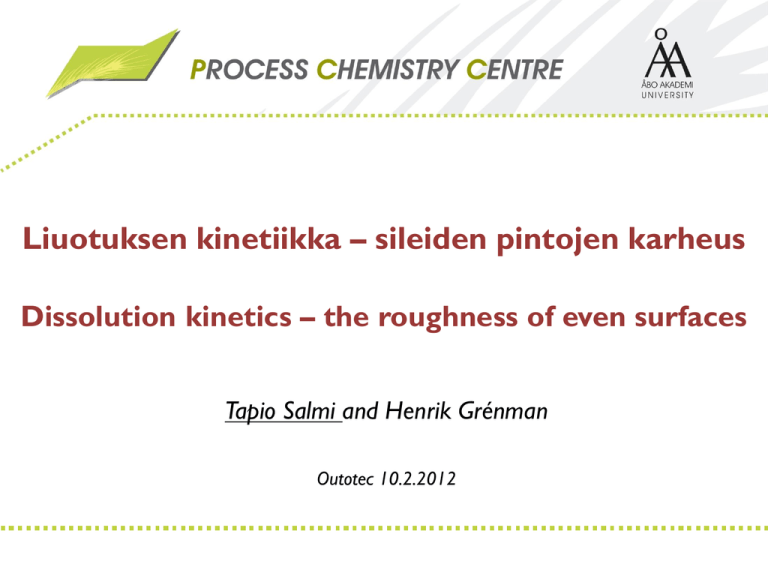
Liuotuksen kinetiikka – sileiden pintojen karheus Dissolution kinetics – the roughness of even surfaces Tapio Salmi and Henrik Grénman Outotec 10.2.2012 Outline Background of solid-liquid reactions New methodology for solid-liquid kinetic modeling Description of rough particles General product layer model Particle size distribution Conclusions Milestones from ÅA perspective Lectures in chemical reaction engineering at ÅA in 70’s: Ready formulae were presented for ideal surfaces for gas solid reactions students did not understand anything At undergraduate library: Denbigh-Turner Chemical reactor theory – the ideal concepts logically explained Organic liquid-phase reaction kinetics [ideal non-porous particles] (Tirronen et al. 1998) Cellulose substitution [completely porous particles] (Valtakari et al. 2003) Zink leaching – old theory and experimental observations in conflict (Heidi Markus (Bernas) et al. 2004) General theory of rough particles (Salmi et al. 2010) General theory for product layer model (Salmi et al. 2011) Particle size distribution (Grénman et al. 2011) Solid-liquid reaction kinetics • The aim is to develop a mathematical model for the dissolution kinetics Why modeling is useful? Modeling helps in effective process and equipment design as well as control Empirical process development is slow in the long run The optimum is often not achieved through empirical development, at least in a reasonable time frame What influences the kinetics A + B → AB → C (l) • Reaction rate depends on – Mass transfer • External • Internal (often neglected) – Intrinsic kinetics (the “real” chemical rates A AB C Practical influence of mass transfer External mass transfer resistance can be overcome by agitation It is important to recognize what you actually are measuring What influences the kinetics Reaction rate depends on Surface area of solid Morphological changes Reactive surface sites on solid Heterogeneous solids Possible phase transformations in solid phase Equilibrium considerations Complex chemistry in liquid phase Traditional methodology The conversion is followed by measuring the solid or liquid phase 12 Koncentration (gram/liter) Concentration 10 8 50°C 6 80°C 4 2 0 0 2 4 6 Time Tid (min) 8 10 Traditional hypothesis in modeling solid-liquid reactions Shrinking particle Sphere Cylinder Slab Shrinking core Traditional kinetic modeling – screening models from literature • The kinetics depends on the surface area (A) of the particles kt 1 (1 ) 1/ 3 dc solid kA particlescliquid dt • Because of the difficulties associated with measuring the surface area online, the change is often expressed with the help of the conversion • Experimental test plots are used to determine the reaction mechanism nr g() f(cS) Type of model 1 -ln(1-) cS/c0S First-order kinetics 2 (1-)-1/2 - 1 (cS/c0S)3/2 Three-halves-order kinetics 3 (1-)-1 (cS/c0S)2 Second-order kinetics 4 1 - (1-)1/2 (cS/c0S)1/2 One-half-order kinetics; two-dimensional advance of the reaction interface 5 1 - (1-)1/3 (cS/c0S)2/3 Two-thirds-order kinetics; threedimensional advance of the reaction interface 6 1 - (1-)2/3 (cS/c0S)1/3 One-thirds-order kinetics; film diffusion 7 [1 - (1-)1/3]2 (cS/c0S)2/3/(1 - (cS/c0S)1/3) Jander; three-dimensional 8 1 - 2/3 - (1-)2/3 (cS/c0S)1/3/(1 - (cS/c0S)1/3) Crank-Ginstling-Brounshtein, mass transfer across a nonporous product layer 9 [1/(1-)1/3 – 1]2 (cS/c0S)5/3/(1 - (cS/c0S)1/3) Zhuravlev-Lesokhin-Tempelman, diffusion, concentration of penetrating species varies with 10 [1 - (1-)1/2]2 (cS/c0S)1/2/(1 - (cS/c0S)1/2) Jander; cylindrical diffusion 11 1/(1-)1/3 - 1 (cS/c0S)4/3 Dickinson, Heal, transfer across the contacting area 12 1-3(1-)2/3+2(1-) (cS/c0S)1/3/(1 - (cS/c0S)1/3) Shrinking core, product layer (different form of Crank-Ginstling-Brounshtein) Surface area of solid phase 25 • The change in the total surface area of the solid depends strongly on the morphology of the particles Cracking 2 Total surface area (m /L) 20 15 Mineral 2 Mineral 1 10 Cylinder Sphere 5 Steadily increasing porosity 0 0 20 40 60 Conversion (%) 80 100 • Models based on ideal geometries can be inadequate for modeling non-ideal cases • The particle morphology can be implemented into the model with the help of a shape factor New methodology for general shapes • The morphology can be flexibly implemented with the help of a shape factor (a) dcsolid Reaction rate: kAparticles cliquid Geometry Shape factor x= dt Reaction rate: Shape factor: dc solid x kc1particles cliquid dt a AP R0 VP 1-x (a) 1/a Slab 1 1 0 Cylinder 2 ½ 1/2 Sphere 3 1/3 2/3 Rough, porous particle high value 0 1 Geometry Shape factor (a) x= 1/a 1-x Slab 1 1 0 Cylinder 2 ½ 1/2 Sphere 3 1/3 2/3 Rough, porous particle high value 0 1 Often kinetics is closer to first order! The roughness is always there, σ=1 m2/g is not a perfect sphere! Detailed considerations give a relation between area (A), specific surface area (σ), amount of solid (n), 1 / a 11 / a A Mn n 0 initial amount of solid(n0), and molar mass (M); a=shape factor New methodology The solid-liquid reaction mechanism should be considered from chemical principles, exactly like in organic chemistry! dcprod dt x kc1particle f (cliquid ) Solid contribution Liquid contribution The dissolution of zink with ferric iron ZnS(s) + Fe3+ ↔ I1 (I) I1+ Fe3+ ↔ I2 (II) I2 ↔ S(s) + 2 Fe2+ + Zn2+ (III) ________________________________________________ ZnS(s) + 2Fe3+ ↔ S(s) + 2 Fe2+ + Zn2+ The mechanism gave the following rate expression k (cFeIII cFeII cZnII / K ) r D 2 2 The dissolution of zink with ferric iron The reaction order is not 2/3 but clearly higher! 0.2 75°C 85°C Fe3+ (mol/L) 0.15 95°C 0.1 0.05 0 0 25 50 75 100 125 150 Time (min) Wrong reaction order in the kinetic model is the worst mistake! General product layer model General product layer model in a nutshell S (a 2) Dei (cLi b cLi s ) s R ( c ik k Li ) 0 a2 R(1 (1 (a 2) / BiMi )(r / R) )(r / R) k 1 d 2 ci (a 1) dci Dei ( 2 )0 r dr dr Ni DeiCR1 a k Li (cLi b cLi *) (a 2) Dei (c Li c Li ) b Ni s R(1 (1 (a 2) / BiMi )(r / R) a 2 )(r / R) S Ni A k 1 ik Rk (cLi s ) S dni dt dc j jM dt ik Rk A k 1 x0 j x c0 j c j 1 x r dci iM x 1 x c0 j c j r dt x0 j r f (cLiS ) Comparison of shrinking particle and product layer model Effect of shape factor Particle size distribution • If the particle size distribution deviates significantly from the Gaussian distribution, erroneous conclusions can be drawn about the reaction mechanism VC = standard deviation / mean particle size Shrinking sphere VC=1.5 VC=0 VC=0 VC=1.2 Implementing the particle size distribution into modeling Total surface area in reactor m² / 100 ml 5 6M 4M 2M 4 3 2 1 0 0 20 40 60 80 % dissolved • Gibbsite is rough/porous and cracks during dissolution • The surface area goes through a maximum, non-ideal behavior 100 Implementing the particle size distribution into modeling x f ( x) x k SP 1 e k (k SP ) k 1 t SP (kSP ) t e dt 0 Var( x) kSP 2 E( x) kSP • The Gamma distribution is fitted to the fresh particle size distribution and the distribution is divided into fractions • The shape parameter (k) and the scale parameter (θ) are kept constant Implementing the particle size distribution into modeling 0.09 ct mt Vt X 1 c0 m0 V0 0.08 Frequency (counts/min) 0.07 0.06 0.05 ri ,t ri ,0 a X time 0.04 0.03 0.02 0.01 0 0 20 40 60 80 100 120 140 160 180 AP a R0 VP Ari ,tP aVri ,tP ri ,tP Diameter (μm) • A new radius is calculated for each fraction and each fraction is summed to obtain the new surface area in the reactor • The new surface area is implemented into to rate equation The fit of the model and sensitivity analysis 80 Concentration (g/L) Concentration (g/L) 80 60 40 20 0 0 5 10 15 20 40 20 0 30 25 60 35 0 20 10 30 Time (min) Time (min) x 10 4 4.5 8000 1000 3.5 5000 900 3 800 2.5 4000 3000 700 2 600 1.5 2000 1 500 1000 0.5 400 0 2 0 3 4 5 6 7 8 shape factor 9 10 11 12 Ea (J/mol) Obj. function Obj. function Obj. function 1100 4 7000 6000 40 0 0.1 0.2 0.3 k0 (1/(min m2)) 0.4 0.5 300 0.8 0.9 1 1.1 1.2 1.3 x 105 Selection of the experimental system and equipment Kinetic investigations Structural investigations Mass- and heat transfer studies Ideas on the reaction mechanism including structural changes of the solid Derivations (and simplification) of rate equations Estimation of kinetic and mass transfer parameters Model verification by numerical simulations and additional experiments Conclusions Modeling is an important tool in developing new processes as well as optimizing existing ones Solid-liquid reactions are in general more difficult to model than homogeneous reactions Traditional modeling procedures have potholes, which can severely influence the outcome Care should be taken in drawing the right conclusions about the reaction mechanisms Things to consider in modeling Some important factors: 1. Be sure about what you actually are measuring 2. Evaluate if the particle size distribution needs to be taken into account (VC<0.3) 3. If the morphology is not ideal use a shape factor to describe the change in surface area (surface area, density and conversion measurements needed) 4. Use sensitivity analysis to see if your parameter values are well defined Some relevant publications Salmi, Tapio; Grénman, Henrik; Waerna, Johan; Murzin, Dmitry Yu. Revisiting shrinking particle and product layer models for fluid-solid reactions - From ideal surfaces to real surfaces.Chemical Engineering and Processing 2011, 50(10), 1076-1084. Salmi, Tapio; Grénman, Henrik; Bernas, Heidi; Wärnå, Johan; Murzin, Dmitry Yu. Mechanistic Modelling of Kinetics and Mass Transfer for a Solid-liquid System: Leaching of Zinc with Ferric Iron. Chemical Engineering Science 2010, 65(15), 4460-4471. Grénman, Henrik; Salmi, Tapio; Murzin, Dmitry Yu.; Addai-Mensah, Jonas. The Dissolution Kinetics of Gibbsite in Sodium Hydroxide at Ambient Pressure. Industrial & Engineering Chemistry Research 2010, 49(6), 2600-2607. Grénman, Henrik; Salmi, Tapio; Murzin, Dmitry Yu.; Addai-Mensah, Jonas. Dissolution of Boehmite in Sodium Hydroxide at Ambient Pressure: Kinetics and Modelling. Hydrometallurgy 2010, 102(1-4), 22-30. Grénman, Henrik; Ingves, Malin; Wärnå, Johan; Corander, Jukka; Murzin, Dmitry Yu.; Salmi, Tapio. Common potholes in modeling solid-liquid reactions – methods for avoiding them. Chemical Engineering Science (2011), 66(20), 4459-4467. Grénman, Henrik; Salmi, Tapio; Murzin, Dmitry Yu.. Solid-liquid reaction kinetics – experimental aspects and model development. Rev Chem Eng 27 (2011): 53–77
